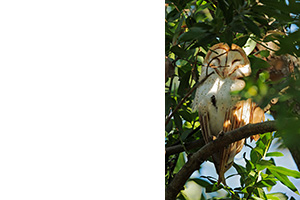 |
Common Barn-Owl
Tyto alba |
|
|
STANFORD LOCATIONS: Several pairs are resident on campus. Nests on artificial ledges and cavities on several buildings, and (probably) natural tree cavities and within the dense crowns of palms. Often seen day-roosting in palms near the mausoleum or seen (and heard) flying over the main campus at night. |
 |
Location |
Type |
Mating System |
Parental Care |
2ndary Diet |
Strategy |
|
|
|
|
I:30-34 DAYS SEMIALTRICIAL 2 |
|
|
|
CAVE |
(3-11) MONOG |
MF |
|
|
| BREEDING: | Open and partly open habitats, esp grassland, farmland, often in or near towns. 1, occ 2 broods. |
| DISPLAYS: | Male claps wings together in courtship flight; ritually presents food to female. |
| NEST: | Also in cliff crevice, occ excavate burrow in arroyo wall. Usu unlined, occ lined with wood chips, sticks, etc. |
| EGGS: | White, often nest-stained. More elliptical than eggs of other owls. 1.7" (43 mm). |
| DIET: | Mostly rodents (esp voles), rarely amphibians, reptiles, insects. Elects pellets. |
| CONSERVATION: | Winters within U.S. Blue List 1972-81, Special Concern 1982-86; widely declining largely due to habitat loss as grassland and farmland reduced by suburbanization. Readily use nest boxes. |
| NOTES: | Clutch size reflects prey availability and severity of preceding winter; fledging success also low following severe winter. Male feeds female throughout incubation. Young hatch asynchronously, spanning up to 14 days. Male and female brood. Sway lowered head from side-to-side when confronted. Roosts diurnally, occ communally, leaving roost singly before sunset and circling upon departure. |
| ESSAYS: | How Owls Hunt in the Dark; Pellets; Blue List; Brood Reduction; Variation in Clutch Sizes. |
| REFERENCES: | Bunn et al., 1982; Colvin, 1985; Cramp, 1985; Earhart and Johnson, 1970; Marti and Wagner, 1985. |
| Help | Abbreviations | Species-Alphabetical | Species-Taxonomic | Essays-Alphabetical | |
| Except for Stanford Locations, the material in this species treatment is taken, with permission, from The Birder's Handbook (Paul Ehrlich, David Dobkin, & Darryl Wheye, Simon & Schuster, NY. 1988). | |||||